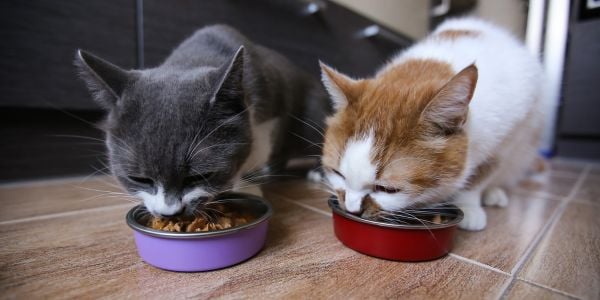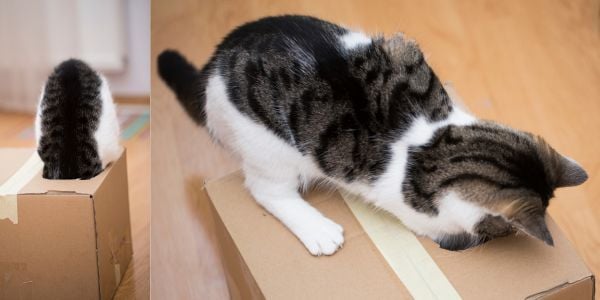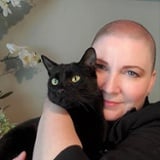You may be one of the lucky few with multiple cats – all great at self-regulating how much they eat, focusing on their own bowls, and not bothering each other during mealtime.
But for most of us, managing meals for more than one cat can be challenging.
And some of us are additionally challenged when one cat is suddenly on a different, possibly medicated food or is gaining weight (or losing) because food is being distributed inappropriately.
That’s why we’re opening the vault and sharing our favorite tips to make your life easier and reduce stress for your cats.
Issues with Feeding Multiple Cats
There are many reasons you may need to employ special tactics at mealtimes, and the solutions may vary based on your issue.
- Food stealing – it’s not about bullying or being greedy. It’s a survival instinct. “There’s food. I need food to survive. I can’t get to food at all times, so I better eat as much as I can right now.”
The concept of "this is my bowl, and that is not my bowl" is not something your cat understands. Food is food.
- Food aggression – especially for cats with a history of food insecurity, protecting your most important resource can seem like the right move.
- Food anxiety or general fear – if you have an anxious or stressed cat, they may be too nervous to eat with other pets around, especially if they don’t get along well.
- Different eating styles – some cats like to graze. Others like to finish all their food in one sitting. Some have food anxiety and will not leave any food behind, even if it’s meant for someone else or they’re full.
- Different diets – throughout a cat’s life, it’s common to need special diets. This can be about weight loss, medical issues like kidney disease or urinary care, food sensitivities, and more. Some of these diets aren’t meant for generally healthy cats, so they can’t be fed to the whole cat family. And others may be too pricey to share.
- Medications and supplements – special medications and supplements are often given in food, so you must ensure only the appropriate kitty is eating from that dish.
It’s not just multiple cats. Sometimes, it’s multiple living creatures.
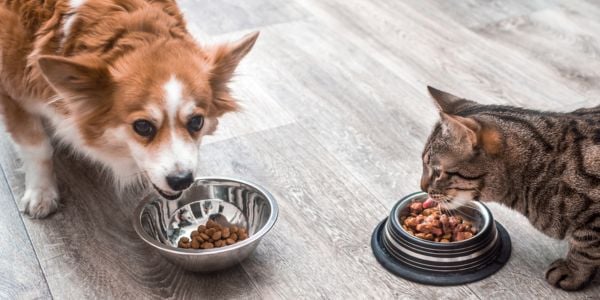
- Dogs and other pets – dogs often get into the cat food. That’s not always as harmless as it sounds. Cats and dogs need different things from food and can react differently to ingredients. Your dog may not be able to digest your cat’s food well.
When I was a kid, one of our dogs had surgery to remove a huge ball of fur and cat food from her stomach. This can be the case for any furballs you have at home — ferrets, rabbits, etc. Even birds can get into the cat food. - Kids – if you’ve got a crawling baby or toddler, you may not want cat food easily accessible to tiny hands and mouths.
The good news is that there are lots of options to address all these issues.
Get Creative With Mealtime Without Spending Money
There are some great devices on the market to manage mealtime. But let’s start with tactics that don’t require you to buy anything.
- Feeding in different rooms – Cats are not social hunters or eaters. They prefer to eat with some distance between them. If your cats tend to finish their meals fairly quickly, make it easy on them and you by just setting their feeding stations up in separate rooms. This is helpful for just about all of the situations listed above.
It’s especially important for fearful cats. You don’t want your cat to associate stress with meals. Letting them eat someplace they feel secure will go a long way to helping reduce their stress generally. This doesn’t work as well if your cats graze throughout the day or you’re not home at mealtimes. - Feeding on different levels – if you have a cat with limited mobility or one who just doesn’t like to be up high, you can feed that kitty on the floor and your other kitty up on a shelf, counter, or even in their cat tree. Make sure there's enough room that your cat won't get so focused on eating that they fall off.
- Feeding with supervision – I’d prefer you not have to monitor your cats while they eat, but it’s certainly an option. Maybe they eat breakfast when you’re having your morning coffee. So, it’s simple to be nearby. You can distract the first one to finish so they don't go bother the cat(s) who are still eating. Or, if the first cat to finish actually leaves a little food behind, you can pick up their bowl so the other cat(s) don't get their leftovers.
- Feeding separately with distractions – you can let one cat eat at a time while the other is focused on something else. For example, maybe your more food-obsessed cat gets a play session while your other cat eats. Then, you can let the food-obsessed cat eat when the first one is done.
- Food puzzles and slow feeders – if you have one cat who eats very quickly and then heads over to eat the other’s food, try slowing them down to give your slower eaters time to finish up. You can feed their meals in a food puzzle (which you can buy or make with things you have around the home). Or you can put something in their food bowl that forces them to slow down a bit. For example, try a large bowl with a smaller bowl or cup upturned inside it. The food will be placed around the inner bowl/cup, making the eating space smaller and slowing your cat down.
Homemade Food Puzzles to Slow Your Cat Down
Try cutting holes around the outside of a box. Drop some dry food in the box. Your cat has to fish out the kibble through the holes as if they were trying to grab a mouse.
Spread your cat’s dry food meal across the cups/divots of an egg crate or ice cube tray. The small cups mean your cat will need to use their paws to pull pieces of kibble out to eat.
Automatic Feeders and Devices That Can Help When Feeding A Few Cats
There are some great, though often pricey, tools to help with the challenges of feeding multiple cats. Even at a higher price, you may find they’re worth it. They can ease your stress and that of your cats. They can protect higher priced food so only the cat who truly needs it is eating it, saving you money. They can keep expensive (or dangerous) medications and supplements going to the correct cat who needs them. Let’s look at a few.
- SureFeed – Good with dry or wet food*. This feeder is a top choice for me personally. I recommend it often to clients. It works using a microchip reader. You can set it so it only opens for the cat whose microchip (or RFID tag placed on a collar) is programmed in. When that cat steps away, a door closes, covering and protecting the food.
It’s great to keep cats out of each other’s food. It can also help with highly food-anxious cats. In time, they will learn that they can walk away from the bowl instead of frantically scarfing down the food, and when they come back later, the food will still be there. This can help teach some cats to self-regulate. However, if your cat can’t walk away from food without scarfing it all down, you’ll need to put smaller portions in the SureFeed throughout the day.
*If using wet food in the feeder, make sure to clean the feeder well, as wet food at room temperature can start to grow bacteria in an hour. A great disinfectant that kills pathogens, doesn't have an odor, and just uses water is the iClean mini.
In the photos below, you'll see my cats using this feeder. It really helped me manage their different diets and needs.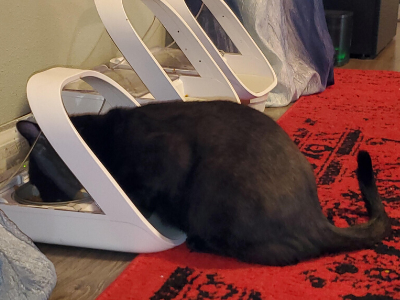
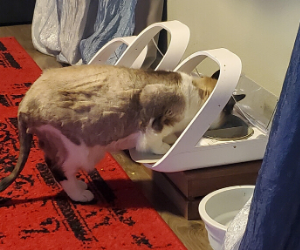
- SureFlap Microchip Pet Door – Using the same technology as SureFeed, this is a pet door you can install and program to only let specific cats in that door. Installing it in a bedroom or laundry room door, for example, means you can keep one cat’s food in that room, and the other cat won’t be able to get to it.
It can take a little training to help your cat understand how the door works. They have to stand there for just a few seconds as it reads their microchip and unlocks. But most cats pick it up quickly. Again, this works best for cats who can self-regulate how much they eat or for households where someone is available to put food out a few times a day. 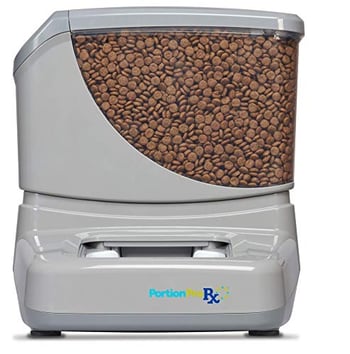 PortionPro Rx — Works only with dry food. I haven’t tried this one. But wow! It sounds like the answer to multiple issues. Like SureFeed, it uses RFID technology to open and close a door, giving access only to the programmed pet. But it also rolls in portion control and auto-feeding.
PortionPro Rx — Works only with dry food. I haven’t tried this one. But wow! It sounds like the answer to multiple issues. Like SureFeed, it uses RFID technology to open and close a door, giving access only to the programmed pet. But it also rolls in portion control and auto-feeding.
You can schedule it to drop a certain amount of food at specific times during the day. This is great if you have a cat who can’t self-regulate or the ideal feeding schedule doesn’t work with your personal schedule. It only works with dry food, but you can always supplement a dry diet via the feeder with a wet diet you feed once or twice daily.
While you can set it to default with the food door open – closing when the non-allowed pet approaches, I’d recommend against it. It could be stressful for a hungry cat to approach food to have access suddenly taken away. Instead, set it up to only open for the allowed pet.- Food puzzles and slow feeders – as mentioned above, food puzzles and slow feeders can slow down fast eaters so your other cat has time to eat their food. You can make or buy them. And there are options for both dry and wet food. We feature a lot of great interactive feeders and puzzles in this article.
An Important Note About Feeding Schedule
Unfortunately, accurate cat care information is not as readily available as it should be. In my work with clients, I find one vital piece of information that often goes unknown. Cats need to eat more than twice a day! They have very small stomachs — about the size of a ping pong ball. That means they can only hold a couple of tablespoons of food comfortably.
Your cat will start to get hungry after about 5 hours. If they’re going more than 8 hours without access to food, you have hungry cats! This means more stress, the potential for food anxiety, increased vocalizing, bothering you for snacks, waking you up early, increased aggression between cats as they worry about competing for a resource they aren’t getting enough of, and even aggression with you.
Your cat should eat at least 3 times daily, if not more.
Ideally, you want no more than 8 hours between meals. If your cat grazes, you’re looking at no more than 8 hours between the time they finish one meal and have access to the next meal. Don’t feed more volume. It’s smaller meals more frequently. That may be one meal first thing in the morning, the second in the late afternoon or early evening, and the last right before bed. You don’t necessarily need to feed your cat overnight. Cats are not nocturnal. They should be sleeping overnight. But they probably get up earlier than you do. An auto-feeder can help you sleep by dropping a snack or meal before you get up.
If you have a cat who “scarfs and barfs,” they’re probably hungry and eating more in one sitting than they should, leading to vomiting. Feeding smaller meals more often will help. It’s also great for weight loss and management.
So don’t worry! If you have issues feeding your cats, there are lots of ways to simplify things for you and reduce stress for them.



